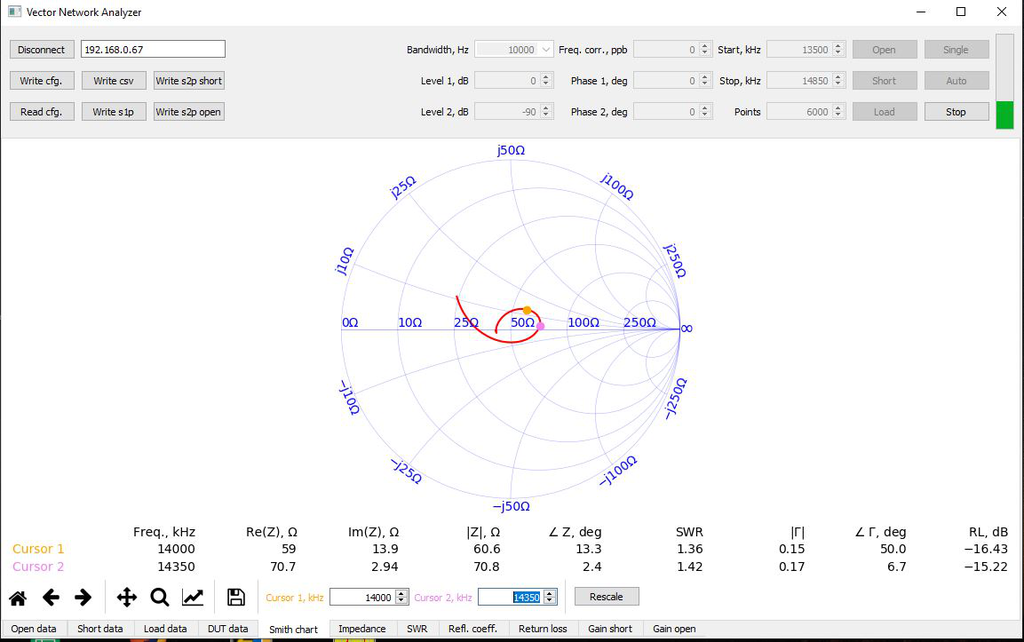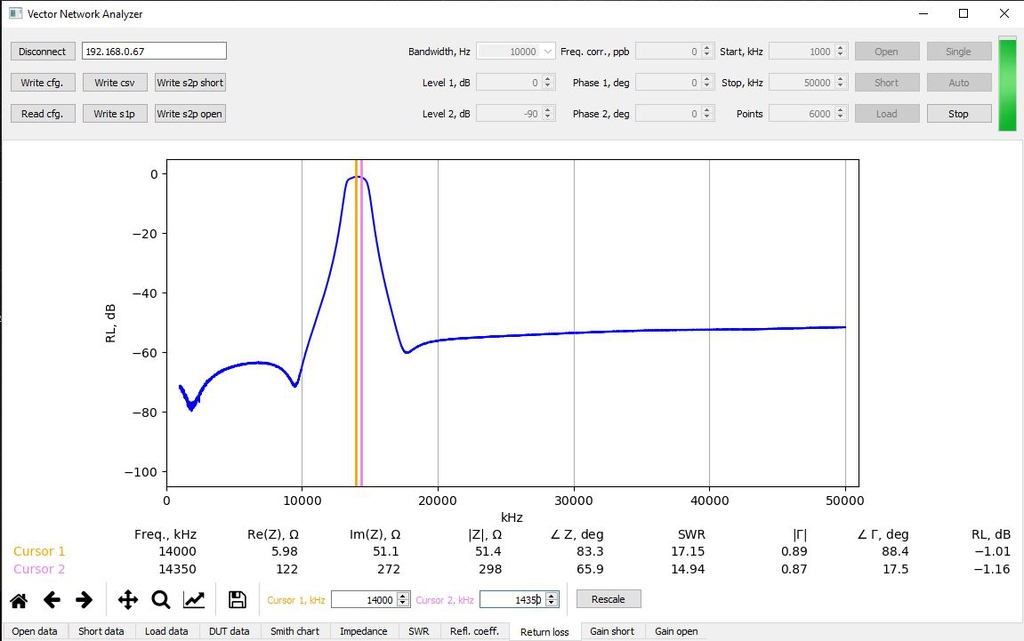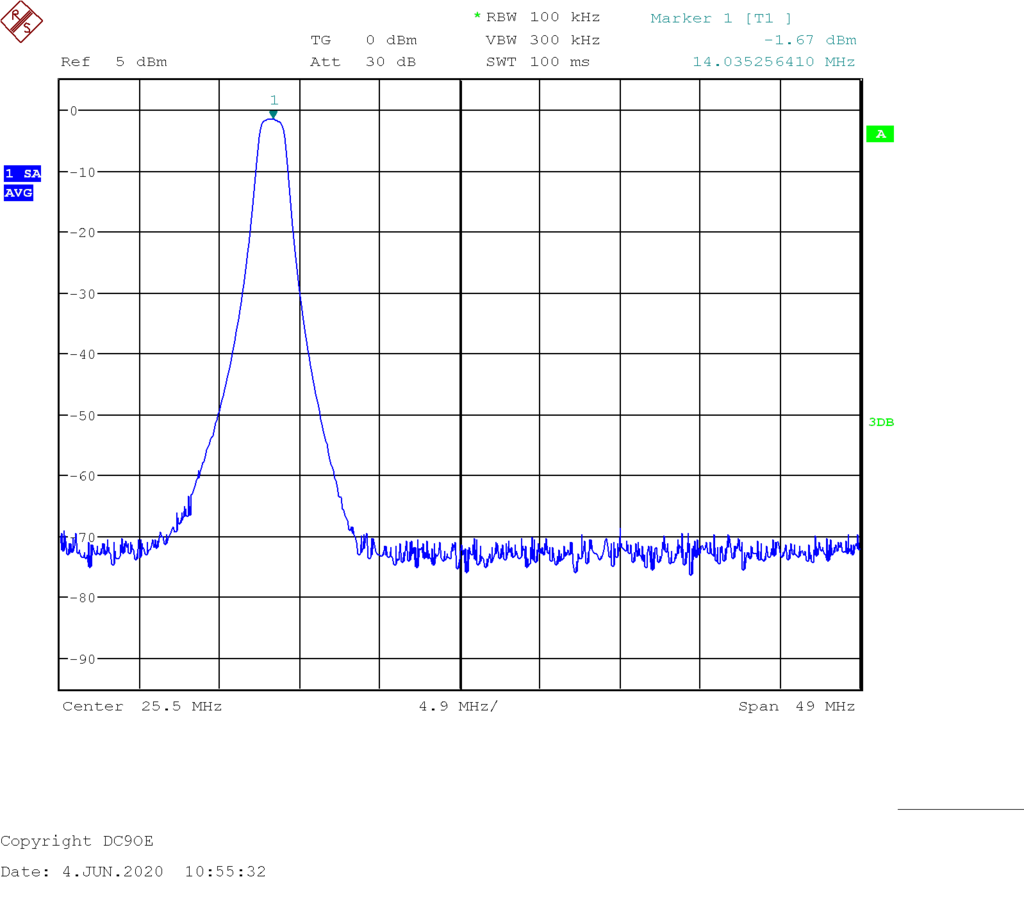Neues von Charly25, verwenden der VNA-Software von Pavel Demin, mit STEMlab 16
Ich denke das sind gute Neuigkeiten für alle STEMlab Fans.
Dank an Markus, DG8MG, für das Hinzufügen der VNA Software von Pavel Demin zu unserem angepassten SD-Karten-Image.
Die einzige kleine Einschränkung besteht in der Notwendigkeit einen 60MHz Tiefpass zwischen STEMlab Output und Messbrücke zu schalten.
Ansonsten würden die diversen Alias Signale eine exakte Messung verhindern.
Hier der Link zum neuen Image:
Der VNA erscheint nun in der Liste der Applikationen:

Hier eine Beispielmessung eines 20m Filters:

Und hier der provisorische Messaufbau mit selbstgebautem Tiefpass am Ausgang des STEMlabs:

73,Edwin – DC9OE
Kleiner Nachtrag noch.
Ich wollte rausfinden ob man mit dem VNA auch Durchgangsmessungen machen kann (für Bandfilter etc.)
Es geht und zwar mit folgender Methode:
- VNA mit Messbrücke kalibrieren wie gewohnt sonst zeigt er nichts an
- Messbrücke entfernen, Schaltbares Dämpfungsglied am Ausgang des STEMlabs
- Ausgang mit Eingang verbinden und die Anzeige für Rückflussdämpfung (RL=Return Loss)auswählen
- Dämpfungsglied auf ca. -13dB bis -14dB einstellen (um den ADC nicht zu übersteuern)
- Die Rückflusdämpfung darf nicht Null anzeigen sondern einen kleinen negativen dB Wert, z.B. -0,3dB
- Dämpfung merken (-0,3dB)
- Filter einschleifen, die Rückflussdämpfung entspricht jetzt der Durchgangsdämpfung des Filters plus der gemerkten – 0,3dB
Die Anzeige ist schnell genug um Bandfilter abgleichen zu können.
Mit der gleichen Methode sollte es auch möglich sein Verstärkung messen zu können.
Hier ein Beispiel für ein 20m Filter:

Und hier die Plausibilitätsprüfung mit einem richtigen Messgerät… hi

Ich hoffe damit bastelfreudigen OM’s eine weitere Möglichkeit aufgezeigt zu haben den STEMlab als einfaches Messgerät zu nutzen.
Mit vorgeschaltetem Filter für 135MHz bis 155MHz müsste es auch auf 2m funktionieren (Frequenz auf 12,23MHz bis 32,12MHz einstellen) – ich habe es aber noch nicht getestet.
73,Edwin – DC9OE









… Just a liitle additiion – we have been made aware of the fact that this announcement could have been interpreted in a way as if Charly 25 has written the VNA SW. Of course this is not the case – the originator of the VNA SW is Pavel Demin.The Charly 25 Team has just invested its time and efforts to make the SW available on STEMlab 16.
We are sorry if this has led to confusion.
In addition we were made aware that the orgininators of various SDR SW and HW pieces we are using are not mentioned well enough.
In our view we have mentioned the originators:
As already stated in all our Github entries and also stated in the header of our GUI’s the underlying SW and HW used by our team is based on:
– PowerSDR mRX PS by HPSDR
– HPSDR/Metis protocol by HPSDR
– VNA program by Pavel Demin
– SDR firmware by Pavel Demin
– SDRlab 122-16 by Red Pitaya
I hope this clarifies the subject. From now on we will announce important news and updates in both English and German language to avoid any misinterpretation of our communication.
73, Edwin – DC9OE
… Just a liitle additiion – we have been made aware of the fact that this announcement could have been interpreted in a way as if Charly 25 has written the VNA SW. Of course this is not the case – the originator of the VNA SW is Pavel Demin.The Charly 25 Team has just invested its time and efforts to make the SW available on STEMlab 16.
We are sorry if this has led to confusion.
In addition we were made aware that the orgininators of various SDR SW and HW pieces we are using are not mentioned well enough.
In our view we have mentioned the originators:
As already stated in all our Github entries and also stated in the header of our GUI’s the underlying SW and HW used by our team is based on:
– PowerSDR mRX PS by HPSDR
– HPSDR/Metis protocol by HPSDR
– VNA program by Pavel Demin
– SDR firmware by Pavel Demin
– SDRlab 122-16 by Red Pitaya
I hope this clarifies the subject. From now on we will announce important news and updates in both English and German language to avoid any misinterpretation of our communication.
73, Edwin – DC9OE